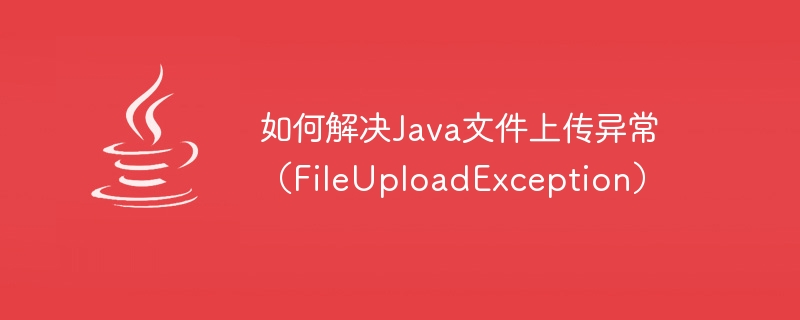How to solve Java file upload exception (FileUploadException)

How to solve Java file upload exception (FileUploadException)
A problem often encountered in web development when uploading files is FileUploadException (file upload exception). It may occur due to various reasons such as file size exceeding limit, file format mismatch, or incorrect server configuration. This article describes some ways to solve these problems and provides corresponding code examples.
- Limit the size of uploaded files
In most scenarios, it is necessary to limit the file size to prevent malicious users from uploading overly large files and causing server load. Too high or the network transmission time is too long. In order to limit the file size, we can use the setFileSizeMax() method provided in the Apache Commons FileUpload library.
ServletFileUpload fileUpload = new ServletFileUpload(); fileUpload.setFileSizeMax(10 * 1024 * 1024); // 限制文件大小为10MB
- Restrict the format of uploaded files
Another common problem is to restrict the format of uploaded files, such as only allowing the upload of pictures or document files. We can use the setFileContentType() method to limit the MIME type of the file.
ServletFileUpload fileUpload = new ServletFileUpload();
fileUpload.setFileContentType(Arrays.asList("image/jpeg", "image/png", "application/pdf")); // 只允许上传JPEG、PNG和PDF文件- Check the file upload status
Sometimes there will be some problems with file upload, such as file damage or upload interruption. In order to ensure the integrity of the file, we can use the isIncomplete() method provided by the Apache Commons FileUpload library to check whether the file is uploaded completely.
ServletFileUpload fileUpload = new ServletFileUpload();
if (fileUpload.isMultipartContent(request)) {
try {
List<FileItem> fileItems = fileUpload.parseRequest(request);
for (FileItem fileItem : fileItems) {
if (!fileItem.isFormField() && !fileItem.isIncomplete()) {
// 处理上传的文件
// ...
}
}
} catch (FileUploadException e) {
e.printStackTrace();
}
}- Handling server configuration issues
Sometimes file upload exceptions may be caused by server configuration issues. For example, a FileUploadException may result if the size of the uploaded file exceeds the server's configured limit. In order to solve this problem, we need to modify the relevant configuration files of the server.
For example, for Tomcat server, you can edit the web.xml file and add the following code to the
<multipart-config>
<max-file-size>10MB</max-file-size>
<max-request-size>20MB</max-request-size>
<file-size-threshold>0</file-size-threshold>
</multipart-config>The above configuration will limit the maximum size of the uploaded file The size is 10MB, the maximum size requested is 20MB, and the file is written to disk instead of memory.
Summary
The key to solving Java file upload exceptions (FileUploadException) is to limit the size and format of uploaded files and check the integrity of the files. We can use the methods provided by the Apache Commons FileUpload library to implement these functions and modify the relevant configuration files of the server as needed. I hope the solutions provided in this article are helpful to you.
The above is the detailed content of How to solve Java file upload exception (FileUploadException). For more information, please follow other related articles on the PHP Chinese website!

Hot AI Tools

Undresser.AI Undress
AI-powered app for creating realistic nude photos

AI Clothes Remover
Online AI tool for removing clothes from photos.

Undress AI Tool
Undress images for free

Clothoff.io
AI clothes remover

AI Hentai Generator
Generate AI Hentai for free.

Hot Article

Hot Tools

Notepad++7.3.1
Easy-to-use and free code editor

SublimeText3 Chinese version
Chinese version, very easy to use

Zend Studio 13.0.1
Powerful PHP integrated development environment

Dreamweaver CS6
Visual web development tools

SublimeText3 Mac version
God-level code editing software (SublimeText3)

Hot Topics
 1376
1376
 52
52
 Square Root in Java
Aug 30, 2024 pm 04:26 PM
Square Root in Java
Aug 30, 2024 pm 04:26 PM
Guide to Square Root in Java. Here we discuss how Square Root works in Java with example and its code implementation respectively.
 Perfect Number in Java
Aug 30, 2024 pm 04:28 PM
Perfect Number in Java
Aug 30, 2024 pm 04:28 PM
Guide to Perfect Number in Java. Here we discuss the Definition, How to check Perfect number in Java?, examples with code implementation.
 Random Number Generator in Java
Aug 30, 2024 pm 04:27 PM
Random Number Generator in Java
Aug 30, 2024 pm 04:27 PM
Guide to Random Number Generator in Java. Here we discuss Functions in Java with examples and two different Generators with ther examples.
 Weka in Java
Aug 30, 2024 pm 04:28 PM
Weka in Java
Aug 30, 2024 pm 04:28 PM
Guide to Weka in Java. Here we discuss the Introduction, how to use weka java, the type of platform, and advantages with examples.
 Smith Number in Java
Aug 30, 2024 pm 04:28 PM
Smith Number in Java
Aug 30, 2024 pm 04:28 PM
Guide to Smith Number in Java. Here we discuss the Definition, How to check smith number in Java? example with code implementation.
 Java Spring Interview Questions
Aug 30, 2024 pm 04:29 PM
Java Spring Interview Questions
Aug 30, 2024 pm 04:29 PM
In this article, we have kept the most asked Java Spring Interview Questions with their detailed answers. So that you can crack the interview.
 Break or return from Java 8 stream forEach?
Feb 07, 2025 pm 12:09 PM
Break or return from Java 8 stream forEach?
Feb 07, 2025 pm 12:09 PM
Java 8 introduces the Stream API, providing a powerful and expressive way to process data collections. However, a common question when using Stream is: How to break or return from a forEach operation? Traditional loops allow for early interruption or return, but Stream's forEach method does not directly support this method. This article will explain the reasons and explore alternative methods for implementing premature termination in Stream processing systems. Further reading: Java Stream API improvements Understand Stream forEach The forEach method is a terminal operation that performs one operation on each element in the Stream. Its design intention is
 TimeStamp to Date in Java
Aug 30, 2024 pm 04:28 PM
TimeStamp to Date in Java
Aug 30, 2024 pm 04:28 PM
Guide to TimeStamp to Date in Java. Here we also discuss the introduction and how to convert timestamp to date in java along with examples.




